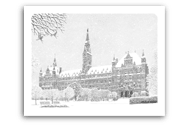Healy
Hall
Washington,
D.C.
#NC-01125-ED - Notecards
#PR-01125-ED - Open Edition Print
The Main Gates
at Georgetown University open toward Healy Hall. Its clock tower,
which chimes every 15 minutes, can be seen and heard from much
of the surrounding area. Healy Hall was designed in the Flemish
Renaissance style by Smithmeyer and Pelz, the architects responsible
for the Library of Congress. In addition to housing University
offices and classrooms, Healy Hall contains Carroll Parlor, repository
for important examples of art from the Renaissance and Baroque
periods, and Riggs Library, one of the few remaining cast-iron
libraries in the nation. The building is on the National Register
of Historic Places.
Healy Hall is named after Rev. Patrick Healy, President of Georgetown
from 1873 to 1882. He was one of ten children of an Irish immigrant
and the mulatto slave he fell in love with on his cotton plantation
in Georgia. Patrick Healy was the first African-American to become
President of a university in the United States.
Text
© 2003 Terry White, Drawing © 2003 Bill Harrah.
|

|
|
Copyright
Notice
Drawings Copyright © 1992-2010 Bill Harrah, Wolf Run Studio (SM), All Rights
Reserved. Wolf Run Studio is a service mark of Bill Harrah and has been in continuous use since 1992. All of the images on this website are in tangible form and are fully
copyrighted. Each has an invisible digital identification which is traceable
through the Digimarc Corporation. Viewers of the Wolf Run Studio website are
allowed to browse and print out images for personal, non-commercial use only.
You may not distribute copies of images or image files to anyone else for any
reason. Images may not be reproduced or used in any form or any manner, or displayed
on any website without the express written consent of Bill
Harrah.
Text Copyright
© 1992-2010
Terry White or
Dianne Harrah. Text on this website is used with permission from the authors.
Viewers of the Wolf Run Studio website are allowed to browse and print out text
for personal, non-commercial use only. Text may not be reproduced or used in any
form or any manner without the express written consent of the authors.
Information
Accuracy
The information for the written description of each location has been carefully
researched by the authors and is believed to be accurate. New findings, however,
could make some information out-of-date. If you are a professional historian,
archaeologist, or architect, and have new information that you are willing to
share, please contact
Dianne Harrah
.
|



